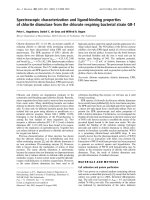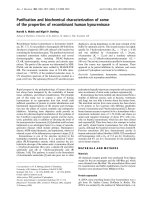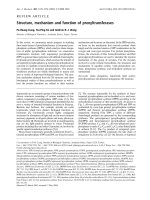Báo cáo y học: "Harry Potter and the structural biologis" docx
Bạn đang xem bản rút gọn của tài liệu. Xem và tải ngay bản đầy đủ của tài liệu tại đây (49.72 KB, 4 trang )
Genome Biology 2006, 7:333
Meeting report
Harry Potter and the structural biologist’s (Key)stone
Damien Devos, Olga V Kalinina and Robert B Russell
Address: European Molecular Biology Laboratory, Meyerhofstrasse 1, 69117 Heidelberg, Germany.
Correspondence: Robert B Russell. Email:
Published: 29 December 2006
Genome Biology 2006, 7:333 (doi:10.1186/gb-2006-7-12-333)
The electronic version of this article is the complete one and can be
found online at />© 2006 BioMed Central Ltd
A report on the first European Keystone symposium
‘Multi-protein complexes involved in cell regulation’,
Cambridge, UK, 18-23 August 2006.
After the first Keystone symposium held outside America,
which took place in October 2005 in Singapore, the first in
Europe was held at St John’s College, Cambridge, UK. As
stated by one of the speakers and clearly felt by many others,
the venue of St. John’s College gave a real ‘Harry Potter’
feeling to the conference, which brought together a multi-
disciplinary group of scientists interested in structures of
large protein complexes and in how structural insights can
aid understanding of cell regulation.
Cells are giant, highly dynamic molecular assemblies. They
contain thousands of protein complexes, the molecular
machines that carry out most of the textbook biological
processes, from DNA replication to metabolism. These
machines are themselves highly regulated and dynamic,
and this regulation is carried out by a host of signaling
processes mediated, in turn, by a great variety of protein
interactions. The conference saw contributions covering all
aspects of cell structure and regulation, from the atomic to
the cellular level, and with subjects ranging from methods
for solving structures to applications of hybrid approaches
for the elucidation of structural aspects of biological
processes.
Structures of complexes and structural biology
Wolfgang Baumeister (Max Planck Institute for Bio-
chemistry, Martinsried, Germany) presented a global vision
of the cell derived from a combination of proteomics and
electron tomography. Tomograms of cells at molecular
resolution are essentially three-dimensional images of the
cell’s entire proteome and reveal the spatial relationships of
macromolecules directly. Approaching 3 nm in resolution,
they provide a fascinating insight into the principles of
supramolecular organization and a basis for studying higher
cellular functions. These tomograms have a fundamental
problem, however: very often one does not know what one is
looking at. To get around this, Baumeister and colleagues are
assembling a molecular atlas of large complexes determined
by X-ray or electron microscopy (EM) methods, in which
each complex is represented as a three-dimensional tem-
plate that can be used as a probe to find possible candidates
inside each tomogram, and subsequently to study aspects of
‘molecular sociology’, or the real networks of molecules in
living systems.
Purification methods, together with proteomics based on
mass spectrometry (MS), have identified hundreds of protein
complexes. Standard proteomics techniques cannot, however,
provide the stoichiometry, subunit interactions and organi-
zation of assemblies. Moreover, because they are hetero-
geneous and often present at relatively low abundances large
complexes can be very difficult to isolate in quantities
suitable for structural studies. New developments are
already addressing these limitations, however. The compo-
sition of complexes can be determined on the large-scale by
techniques such as tandem affinity purification (TAP).
Bertrand Seraphin (CNRS, Gif-sur-Yvette, France) reviewed
the structural and functional analysis of protein complexes,
starting with TAP coupled to MS (TAP/MS) for determination
of stoichiometry, and described how sufficient material for
structural studies can now be obtained for low-abundance
complexes by coupling overexpression with TAP. He discussed
applications of his approaches, in concert with structural
techniques such as small-angle scattering and X-ray to study
various assemblies, including the exon-junction complex.
On a related theme, Carol Robinson (Cambridge University,
Cambridge, UK) explored the interplay between MS and
electron microscopy to uncover the composition, stoichio-
metry and structure of complexes. The overall shape of
complexes can be determined by MS by measuring the
traveling time through the device, in a manner similar to gel
filtration. But the shape describes the external envelope and
not details of what is inside. She also demonstrated an
innovative way to deduce subunit organization by the
analysis of subcomplexes derived from a larger assembly.
She also presented a fascinating possibility: coupling MS to
electron microscopy by placing the microscopy grid on the
collision detection device of the spectrometer in order to
visualize complexes directly. In this way TAP and MS with
electron microscopy can be combined to compensate for the
individual challenges of each technique: TAP can be used to
isolate sufficient quantities of highly pure native complexes,
and MS of the intact assemblies and subcomplexes can be
used to determine their structural organization.
There is still a large gap between the number of complexes
thought to exist on the basis of data from two-hybrid or
affinity-purification screens and those for which three-
dimensional structures are available. Moreover, there are
many lower-resolution structures now produced for large
complexes by electron microscopy, and models for protein
complexes can often help to interpret them. This has defined
the next generation of structure prediction - the techniques
that must now tackle whole complexes or systems if they are
to have the most impact in biology.
Andrej Sali (University of California, San Francisco, USA)
presented an approach for determining low-resolution
structures of complexes by the satisfaction of restraints
derived from a plethora of experimental and theoretical data,
and its application to the yeast nuclear pore complex, which is
approximately 50 MDa in size and contains about 480
proteins. The spatial restraints on the symmetry, protein
positions and protein relationships were determined using
affinity chromatography, electron microscopy and ultracentri-
fugation measurements by the groups of Michael Rout and
Brian Chait at Rockefeller University (New York, USA). The
final nuclear pore complex structure resolves the approximate
position of each protein and has already provided a number of
insights into the function and evolution of this complex.
One of us (R.R.) discussed some 500 complexes deduced
from a full genome screen using TAP/MS and described how
complex structures that are already known can be used as
templates to model others inside the interactome. This talk
highlighted the growing number of interactions known to be
mediated by short peptide stretches and described methods
to find short recurring peptides that bind particular domains,
possibly providing new target sites for allosteric drug-
discovery approaches, such as that of Jim Wells (see below).
Reversing the paradigm: interactions as drug
targets
Protein interfaces were a hot topic this year, with many
presentations devoted to their study and to new ways of
modulating them for applications in disease. The principles
of protein interaction were reviewed by Tom Blundell
(Cambridge University, Cambridge, UK), who opened the
meeting. He focused specifically on comparing the interfaces
of signaling complexes with those in other complexes. He
discussed how a multitude of weak binary interactions can
lead to stable multiprotein complexes in a ‘velcro-like’
manner. He also summarized the traditional pharmaceutical
company criteria for ‘druggability’ of surfaces (their
suitability for targeting by drugs), which largely dismiss flat,
shallow, flexible surfaces. He went on to suggest that proteins
that form interactions with ligands comprising a continuous
region of flexible peptide could be more druggable than
preformed complexes of globular protein structures.
Jim Wells (University of California, San Francisco, USA)
presented the technique of disulfide tethering for identifying
binding or allosteric sites in protein-protein interaction.
Allosteric inhibitors are of growing interest for drug
discovery, particularly when traditional active-site inhibition
fails to deliver good candidate molecules. In the approach
presented, some residues on a protein surface near the
targeted site are mutated to cysteines, which lock in thio-
labeled chemical fragments whose affinity is, at best, in the
low micromolar range. Interlinking these cysteines, followed
by some optimization by synthetic chemistry, can quickly
lead to molecules of sub-nanomolar affinity; for example,
inhibitors have been found in this way for caspases, for
which active-site inhibitors have a poor clinical history.
Perhaps the most impressive display of the technique was
the targeting of the surface of interleukin-2 near to the
known receptor-binding site. Although the site did not seem
druggable, Wells and colleagues managed to synthesize a
compound that clearly mimics receptor binding and binds
with sub-nanomolar affinity.
Similarly, Steve Fesik (Abbott Laboratories, Abbott Park,
USA) has applied nuclear magnetic resonance (NMR) and
many other structural approaches to derive inhibitors for
the anti-apoptotic protein Bcl-2 with a view to developing
new cancer drugs. After developing compounds targeting
the interaction between Bcl-2 and the pro-apoptotic protein
Bak, and facing off difficult challenges such as eliminating
binding to serum albumin, they obtained a specific
nanomolar inhibitor that mimics the helical conformation
of Bak.
Nadia Milech (University of Western Australia, West Perth,
Australia) showed that it is sometimes sensible to abandon
direct approaches to designing molecules that target molecular
interactions, and instead to see if there is a suitable
candidate already occurring in nature. She has searched for
random fragments of bacterial genomes (phylomers) that act
as inhibitors of protein-protein interactions, and discussed
333.2 Genome Biology 2006, Volume 7, Issue 12, Article 333 Devos et al. />Genome Biology 2006, 7:333
fascinating potential applications of candidate peptides to
wound healing.
Hybrid approaches in development and in
practice
“At structural conferences of ten years ago”, Chris Dobson
(Cambridge University, Cambridge, UK) commented, “you
might have heard a little bit about electron microscopy, and
something about mass spectrometry, but today nearly every
structural problem has been studied using at least three
techniques, or more.” This captured one of the themes of the
meeting, that hybrid approaches are the order of the day,
and indeed, when dealing with large molecular assemblies,
they are a must.
There are still new hybrid approaches to be explored,
including such seemingly unlikely bedfellows as NMR and
small-angle scattering (SAXS). Determination of the three-
dimensional structures of multidomain proteins by
solution NMR methods presents unique challenges related
to the fact that these proteins are normally much larger
than structures typically solved by NMR, and the usual
scarcity of constraints at the interdomain interface, which
often results in a decrease in structural accuracy.
Alexander Grishaev (National Institute of Diabetes and
Digestive and Kidney Diseases, National Institutes of
Health, Bethesda, USA) demonstrated that in this respect,
experimental information from SAXS can be used as a
complement to NMR, as it provides an independent
constraint on the overall shape a molecule can have. SAXS
is not affected by isotopic labeling and measurements can
be done very quickly, in small sample volumes, and in
conditions that match the NMR experiment. Moreover,
SAXS data can be incorporated naturally into NMR
structure calculations. Whatever the combination of
methods used, the power of hybrid approaches is best
illustrated by applications to particular systems, of which
plenty were presented at the meeting. A variety of
multidisciplinary approaches were applied to a multitude
of complexes, and interdisciplinarity and system-level
analysis were mentioned by most speakers.
Much of the complexity of signaling was nicely put together
in a provocative talk by Yosef Yarden (Weizmann Institute,
Rehovot, Israel), who presented a model of a signaling
network that was based on an analogy with electrical circuits
and other human-built networks. Specifically, he argued that
it is useful to envisage signaling by the epidermal growth
factor receptor ErbB as a bow-tie-shaped evolvable network,
which shares modularity, redundancy and control circuits
with robust biological and engineered systems. Because
network fragility is an inevitable trade-off of robustness, a
systems-level understanding would be expected to generate
therapeutic opportunities to avoid aberrant network
activation. The fragility of the ErbB network provides
opportunities for cancer therapy; it predicts better efficacy
for drugs targeting multiple aspects of the same pathway,
such as phosphorylation and binding of Hsp90 to the same
kinase, as has been found for some inhibitors.
Amyloids everywhere
Amyloids are insoluble fibrous aggregations, sharing a
common -cross structure, formed by many different
proteins. Some of the biggest players in the world of
amyloids were present at the meeting, and this provided for
a fascinating session on this subject. David Eisenberg
(University of California, Los Angeles, USA) first reviewed
the principles of amyloid fibril formation and then discussed
his work studying the structures of amyloid fibrils using
X-ray crystallography. The structures revealed very tight,
close-packed interfaces, and certain common patterns of
formation, in particular self-complementarity, which allows
tight interdigitation. This group extended this work with
David Baker (University of Washington, Seattle, USA) to
find new sequences that fit onto the close-packed structure,
which led to several surprising predictions of amyloid
formation (such as by myoglobin and lysozyme). Context
does have a role in the ability of a protein segment to form
amyloids, however, because ribonuclease, which seems to
contain a suitable segment, has never formed amyloids in
more than ten years of harsh laboratory treatment.
Dobson explained that there was little in common among the
60 proteins that have so far been converted to form
amyloids, and that perhaps amyloid formation is a generic
feature of proteins and that proteins differ only in terms of
the propensity to form these structures. He then presented
applications of nanotechnology (such as nanoscale canti-
levers) to uncover the strength and structure of amyloid
fibers, and ended with his group’s attempts to treat amyloid
formation in flies by redesigning amyloid fibers. He also
presented fascinating early work studying folding and
misfolding on the ribosome by NMR, which promises to
revolutionize our understanding of nascent chain folding.
Sheena Radford (University of Leeds, Leeds, UK) followed
by discussing the ‘knife-edge’ in folding landscapes, meaning
the delicate balance between folding, aggregation and
amyloid formation. She studied 
2
-microglobulin, almost all
of which can form amyloid, and found mutations that
isolated an amyloid-forming folding intermediate (at an
edge strand in the structure). The electron microscopy
pictures of these fibers reveals some surprises: they do not
seem to form a generic -cross structure.
Predicting function and interaction from
structure(s)
More than half of the genes in most genomes are still of
unknown function, and the output from structural genomics
Genome Biology 2006, Volume 7, Issue 12, Article 333 Devos et al. 333.3
Genome Biology 2006, 7:333
initiatives has now provided structures for thousands of these
that (alone) say little about protein function. Computational
procedures are still needed to make sense of a bewildering
array of data. Janet Thornton (EMBL European Bioinformatics
Institute, Hinxton, UK) opened a computational section of the
meeting by discussing her work on predicting function from
structure. Her group’s Catalytic Site Atlas [http://www.
ebi.ac.uk/thornton-srv/databases/CSA/] describes the residues
involved in catalysis, as identified by structural and bio-
chemical experiments, for nearly 500 proteins. They have
also developed approaches to compare these sites, and the
ligands that bind to proteins of known structure, in order to
predict new potential catalytic or binding sites on protein
structures of unknown function. All these tools are being
used to help predict function from structure in European
and US structural genomics projects.
As was so often demonstrated at the meeting, proteins rarely
act alone. Thus, the many thousands of structures now
known are likely to interact with others, but determining
complex structures experimentally remains difficult. This
makes methods to predict how two protein structures might
interact - docking methods - ever more relevant in structural
biology. To develop effective methods one needs first,
however, to understand principles of interaction. Joel Janin
(CNRS, Orsay, France) described an approach to
understanding what it is about interaction interfaces that
makes them distinct from crystal packing. In addition, the
approach also revealed interesting properties of the true
biological interfaces.
Janin also introduced the Critical Assessment of the
Prediction of Interactions (CAPRI) experiment, in which
docking approaches are subjected to regular double-blind
trials. Progress has been clear, with at least one group now
providing a near correct structure for nearly every target
submitted. Juan Fernandez-Recio (Institute for Research in
Biomedicine, Barcelona, Spain) then presented his work on
one of the most successful approaches, showing how recent
improvements in docking methods, particularly information
from binding-site predictions or evolutionary conservation,
can improve performance dramatically.
In conclusion, hybrid experimental and computational
approaches have put us well on the way towards determining
structures for many thousands of complex structures, and to
placing them in the context of the whole cell. This will not
only reveal the real molecular organization of a cell but will
also allow systems biology to move from abstract
representations to the physical world. The time when we can
wave Harry Potter’s magic wand and zoom in on any part of
a cell at atomic level detail is surely just around the corner.
Acknowledgements
D.D. is supported by the EU-grant ‘3D repertoire’, contract no.
LSHG-CT-2005-512028. O.V.K. is supported by INTAS Fellowship Grant
for Young Scientists (04-83-3704) and program ‘Molecular and cellular
biology’ of the Russian Academy of Sciences.
333.4 Genome Biology 2006, Volume 7, Issue 12, Article 333 Devos et al. />Genome Biology 2006, 7:333









